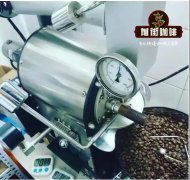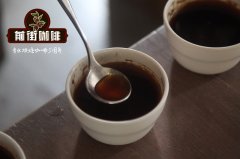Is the frequently drunk mocha the difference between a Yemeni mocha and a Yemeni mocha?

Professional coffee knowledge exchange more coffee bean information please follow the coffee workshop (Wechat official account cafe_style)
Coffee originated in Ethiopia, which is located in the East African Plateau, where high-grade Karabica hand-dried coffee beans, named after Guduhara, have been produced here for nearly 2000 years. More than 1500 years ago, coffee trees were introduced to Yemen on the other side of the Red Sea, thus embarking on a world tour of coffee beans. Yemeni coffee beans are exported from the port of Mocha (now silted and abandoned) to all parts of the world (mainly to Europe through Turkey). So Yemeni coffee beans get their name from the export port, which is what we often see today as "mocha beans". What's the difference between mocha beans, mocha coffee and mocha pot?
Mocha bean
[mocha beans]: produced in Ethiopia, the beans are small and fragrant, with a strong sour and alcoholic taste, slightly alcoholic, spicy, moderate sweetness and special flavor. It is a well-known high-quality coffee, usually drunk individually. At present, the coffee produced in Yemen is the best, followed by Ethiopia's mocha; mocha coffee belt smooth in the acid to strong acid, sweet, unique flavor, containing chocolate flavor; with the temperament of a lady, is a very characteristic pure coffee.
Mocha (Mocca because the bean shape is very small, also known as small mocha) in Central and South America, the small mocha is not only small, but also the yield is low, generally small mocha beans are about 10 to 11 orders, that is, beans are between 0.39cm and 0.43cm, which is much smaller than the average 18-purpose Central American beans and 0.7cm beans. Notice that the little mocha has a flat surface, that is, a fruit contains two raw beans. Of course, small mochas also have small round beans, but the proportion is only 2%, which is much lower than the 5% to 10% of the average Arabica.
Mocha pot
Since Yemen was the main exporter of coffee in the world before the European colonial tide, the word "mocha" has been synonymous with Yemeni coffee beans for quite a long time. It actually means a coffee pot.
The mocha pot is composed of the upper pot, the filter screen and the lower pot, and the filter net is located between the upper pot and the lower pot. When brewing, the water is placed in the lower pot, and the coffee powder is placed in the middle of the filter; when the lower pot is heated, it produces water vapor, forming a force of about atmospheric pressure, pushing the hot water upward, passing through the coffee powder and the thin tube in the pot, and touching the lid of the pot. It falls into the upper pot to form a coffee liquid.
[main point]: heat the correctly installed mocha pot on the heat source. The key to filling a mocha pot with real powder is to fill it as much as possible instead of pressing it tight. The powder can be injected in batches when loading the powder, and the edge of the powder trough can be covered as much as possible without leaving any gap. For ease of observation, I suggest boiling the mocha pot with the top open.
Soon the coffee liquid overflowed from the central metal column of the upper seat.
With the continuous extraction, the liquid level of coffee will rise gradually. When there is grease on the liquid surface, please be careful that the coffee extraction is coming to an end. When the color of the oil changes from dark to light, the heat source should be cut off immediately to stop the extraction, otherwise the coffee will be in a state of over-extraction.
In particular, you can't stop after the sound of "snoring". This kind of coffee may even have the taste of roasted rubber.
Because it forms about twice the atmospheric pressure, it is classified as. High-pressure cooking. In addition, some people call it. A handmade espresso pot. I don't agree with you here, because it doesn't meet the standard of espresso, and it can't make that layer of Crema, but it's really a "powerful" drip filter coffee, and it's always been favored by people with strong tastes.
PS: the mocha pot is very sensitive to capacity. Be sure to make coffee according to the capacity of the pot. If you have a mocha pot for 2 people, make 2 cups at a time. If you brew only one cup, the coffee powder is not thick enough, the resistance to hot water is insufficient, and the hot water will run through quickly, so that only one cup of coffee with poor extraction can be made. The mocha pot on the market has 1. 2. 3. 6. 9. 12 and 18 people have the same capacity, you should carefully consider your needs before buying.
Mocha Coffee
The origin "mocha" beans are full of wild flavor due to the ancient manual drying method, and there is a strong "chocolate flavor" in the afterrhyme, so in Italian coffee, "chocolate coffee" is called "mocha coffee". Like the classic Italian latte, it is usually made of 1/3 Espresso and 2/3 foam, but it also adds a small amount of chocolate.
Chocolate is usually added in the form of chocolate syrup, but some coffee selling systems are replaced by instant chocolate powder. Sometimes, whipped cream, cocoa powder, and cotton candy are added to add to the aroma of coffee and as a decoration. Unlike the Italian Cappuccino, there is no milk foam on the mocha. Instead, mocha coffee is usually topped with cream and cinnamon or cocoa powder. It is also possible to add sunflower honey powder to the surface as decoration and add flavor.
Yemeni coffee bean brand recommendation
The Yemeni mocha beans baked in Qianjie Coffee are fully guaranteed in terms of brand and quality. And more importantly, the performance-to-price ratio is extremely high, a pack of 227 grams, the price is only 85 yuan. According to the calculation of 15 grams of powder per cup of coffee, a bag of coffee can make 15 cups of coffee for less than 6 yuan each, which is recommended by conscience compared to the price of tens of yuan a cup sold in a coffee shop.
Related recommendation: I heard that drinking mocha coffee has many benefits? What's the price of mocha coffee?
Important Notice :
前街咖啡 FrontStreet Coffee has moved to new addredd:
FrontStreet Coffee Address: 315,Donghua East Road,GuangZhou
Tel:020 38364473
- Prev

Is mocha coffee individual coffee or fancy coffee? what's the difference?
Professional coffee knowledge exchange more coffee bean information please follow the coffee workshop (Wechat official account cafe_style) mocha coffee ingredients / cup quantity Espresso 30ml steam cream chocolate sauce utensils 200cc coffee cup Step 1 pour chocolate sauce 10ml into the cup mocha coffee-step 1 Step 2 extract Single Epresso 30ml mocha coffee-
- Next

What does golden manning mean? the difference in taste between Indonesian manning and golden manning coffee beans
Professional barista communication please follow the coffee workshop (Wechat official account cafe_style) golden manning: some friends who opened a coffee shop a few years ago said that golden manning is an old manning. When it comes to Golden Manning, let's start with PWN, an acronym that is often mixed with the name Manning Coffee.
Related
- Beginners will see the "Coffee pull flower" guide!
- What is the difference between ice blog purified milk and ordinary milk coffee?
- Why is the Philippines the largest producer of crops in Liberia?
- For coffee extraction, should the fine powder be retained?
- How does extracted espresso fill pressed powder? How much strength does it take to press the powder?
- How to make jasmine cold extract coffee? Is the jasmine + latte good?
- Will this little toy really make the coffee taste better? How does Lily Drip affect coffee extraction?
- Will the action of slapping the filter cup also affect coffee extraction?
- What's the difference between powder-to-water ratio and powder-to-liquid ratio?
- What is the Ethiopian local species? What does it have to do with Heirloom native species?

